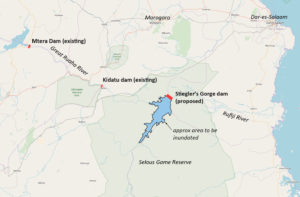by Ben Taylor
The government remain undeterred in its plans to construct a large dam in the Rufiji River, at Stiegler’s Gorge in the Selous Game Reserve, [see also TA 120] despite concerns expressed by conservationists and MPs.
Conservation groups including the World Wildlife Fund (WWF) and the International Union for Conservation of Nature (IUCN) have raised concerns since the project was mooted in 2009 and have consistently called for the project to be abandoned. The IUCN called the project “fatally flawed.”
The Selous Game Reserve is one of the last major expanses of wilderness in Africa. It’s a protected UNESCO World Heritage Site the size of Switzerland. Since 2014, it has been on UNESCO’s List of World Heritage in Danger, primarily because of elephant poaching. In less than 40 years, the park lost 90% of its elephants.
However, the planned hydropower dam could have an even more devastating impact. At 130 meters (427 feet) in height and stretching 700 meters across the canyon, the dam will create a lake of 1,500 square kilometres and will generate up to 2,100 MW of power.
“The dam would destroy one of the most important habitats for wildlife and the heart of the game reserve, where most of the animals roam, especially in the dry season. It would open up that whole area for industrialization, infrastructure and settlements,” said Johannes Kirchgatter of the Africa Program for WWF Germany. “If you’re standing in the middle of Selous now, it’s a fantastic wilderness, there is wildlife all over, and all of that would be gone… It would be a great loss for us and the generations to come.”
The dam would also have a significant impact on livelihoods further downstream. A WWF report found the dam would trap most of an estimated 16 million tons of sediment and nutrients carried by the river every year, leading to soil erosion and cutting off lakes and farmland downstream. The Rufiji delta, home to fish, shrimp and prawn fisheries, as well as the largest mangrove forest in East Africa, would also be starved of water. In all, the construction of the dam could damage the livelihoods of over 200,000 farmers and fishermen, according to the WWF.
The IUCN said that the project is ‘fatally flawed’ because of its ecological impact. It called on Tanzania to ‘permanently abandon’ it.
The Director-General of UNESCO, Audrey Azoulay, wrote a letter in January expressing her concern about the irreversible damage the project could have on the Selous. The World Heritage Committee (WHC) of UNESCO, which lists the Selous as a World Heritage Site, expressed its “utmost concern,” saying the dam project has a “high likelihood of [causing] serious and irreversible damage.” The WHC added the Stiegler’s Gorge project as a new factor that endangers the Selous ecosystem.
The government rejects this criticism. When WWF published its report in 2017, tourism minister Jumanne Maghembe insisted the hydropower was needed to transform Tanzania’s economy.
President John Magufuli has said the dam and resulting reservoir would cover only 3% of the Reserve, adding that he would not listen to detractors who spoke “without facts.”
The government is pushing ahead to fell more than 2.6 million trees from the area that would be flooded by the dam.
Now Tanzania has taken its defence of the project to UNESCO. At the 42nd meeting of the World Heritage Committee, held in June in Bahrain, Tanzania cited sustainable development to push for the project.
Major General (rtd) Gaudence Milanzi, Permanent Secretary in the Ministry of Natural Resources and Tourism, said Tanzania has maintained its position to continue with the project as stated during a meeting of the committee in Poland last year. He explained that the dam was primed to play a critical role in the vision of the government to industrialise the economy.
In a separate development, the Minister of State in the Vice President’s Office for Union Matters and the Environment, January Makamba, stated on Twitter that a new Environmental Impact Assessment (EIA) has been completed, such that the previous EIA published in 2009 will no longer be used. The new EIA has been conducted by the Institute of Resource Assessment of the University of Dar es Salaam, he explained. “Its report was submitted last week by Tanesco,” he posted. “A team from [the National Environmental Management Committee] (NEMC) will visit the project this week to verify and talk to the community and stakeholders.”
MPs have also questioned the order of developments, asking why the decision to fell so many trees had been taken before the EIA had been completed. “I wonder why the government wants to move on with the project and yet we know well there will be an impact, especially due to felling of trees. Let us get the EIA n the project,” said Peter Msigwa (Chadema, Iringa Urban). Similar points were made by Zitto Kabwe (ACT Wazalendo, Kigoma Urban) and Nape Nnauye (CCM, Mtama).
Other MPs disagreed. “The tone here is as if all trees around the country will be cleared. Some people are just not patriotic; and I think patriotism should be taught starting from nursery school,” said Mr Omary Mgumba (CCM, Morogoro Rural). “The environment exists to serve human beings and not the opposite.” Dr Raphael Chegeni (CCM, Busega) asked MPs to reduce complaints as projects such as Stiegler’s Gorge were a result of their demand to ensure reliable power generation.”
The Deputy Minister in the Vice President’s Office for Union Affairs and the Environment, Mr Kangi Lugola, told parliament the government would go on with implementation of the project “whether you like it or not.” He added that “those who are resisting the project will be jailed.” Mr Lugola has since been promoted to Home Affairs Minister.

